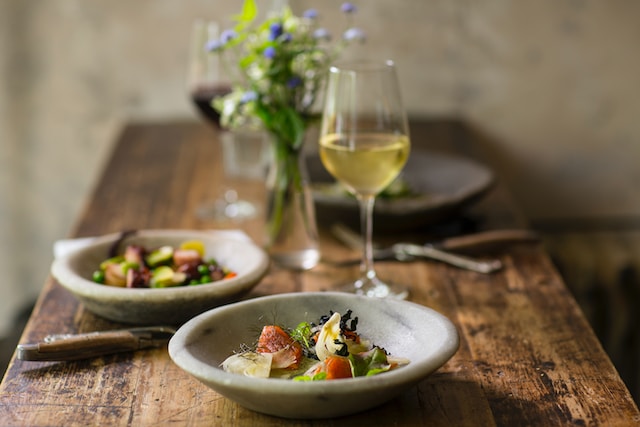Wine and food pairing is a delightful art that can elevate your dining experience to new heights. It’s a practice that has been perfected over centuries, resulting in a symphony of flavors that dance on your palate. Whether you’re a seasoned sommelier or a casual wine enthusiast, understanding the principles of wine and food pairing can greatly enhance your culinary adventures. In this article, we will explore the fascinating world of wine and food pairing, discussing the fundamental principles, common misconceptions, and some exceptional pairings that will tantalize your taste buds.
The Fundamental Principles Of Wine And Food Pairing
Pairing wine and food is not about rigid rules but rather a creative exploration of complementary flavors and textures. To start, consider the weight and body of both the wine and the dish. Light wines, such as Sauvignon Blanc, pair wonderfully with delicate dishes like seafood and salads, while full-bodied wines like Cabernet Sauvignon are best suited for robust fare like steak and hearty stews. The goal is to strike a harmonious balance; neither the wine nor the food should overpower the other.
Acidity is another critical factor. High-acid wines, like Pinot Grigio or Champagne, can cut through rich, creamy sauces, providing a refreshing contrast. On the other hand, wines with lower acidity, such as Merlot or Chardonnay, work beautifully with dishes that have buttery or velvety textures. Tannins, found in red wines, can be tamed by the protein in meat, making them a classic pairing for a reason.
The Art Of Contrasting And Complementing Flavors
Mastering wine and food pairing involves the art of contrasting and complementing flavors. Contrasting flavors, such as pairing a dry, tannic wine with a creamy pasta dish, create a dynamic interplay that excites the palate. The wine’s astringency cuts through the richness of the dish, making each bite feel fresh and balanced. On the other hand, complementing flavors involves harmonizing similar elements in both the wine and the food. For instance, a buttery Chardonnay such as the one from Teperberg Winery complements the buttery notes of lobster, creating a seamless, luxurious experience. Experiment with both approaches to discover your preferences.
Common Misconceptions About Wine And Food Pairing
One common misconception is that white wine must always accompany seafood and red wine should be reserved for meat dishes. While this can be a good starting point, it oversimplifies the possibilities. For example, a light, crisp Rosé can be a delightful match for grilled shrimp or salmon. Similarly, a well-chilled Pinot Noir can beautifully complement a tuna steak.
Another myth is that you should always pair wine from the same region as the dish you’re eating. While there’s merit in exploring regional pairings, don’t limit yourself. International wines can often offer unique and surprising flavor combinations. For instance, try a Spanish Tempranillo with Italian pizza, and you may discover a match made in culinary heaven.

Exceptional Wine And Food Pairings
For a memorable dining experience, consider some exceptional wine and food pairings that go beyond the ordinary. A spicy Thai curry can find its ideal partner in a slightly sweet Riesling, as the wine’s sweetness balances the heat of the dish. If you’re indulging in a decadent chocolate dessert, don’t shy away from a robust Port wine; the wine’s dark fruit flavors and hint of nuttiness provide a luxurious finale to your meal.
When enjoying a cheese platter, explore the world of fortified wines like Sherry or Madeira. Their complexity and range of flavors can complement a variety of cheeses, from tangy blue to creamy brie. And for a brunch with eggs Benedict, don’t overlook a crisp sparkling wine like Prosecco, as the effervescence and acidity cut through the rich hollandaise sauce.
Exploring The Influence Of Terroir
Terroir, the unique combination of soil, climate, and geography in a wine-producing region, plays a significant role in wine and food pairing. Understanding how terroir impacts wine can enhance your pairing choices. Wines from cooler climates often exhibit higher acidity, making them perfect companions for dishes with zesty, citrusy elements. Consider pairing a crisp New Zealand Sauvignon Blanc with ceviche to experience this synergy. Conversely, wines from warmer regions tend to have more pronounced fruitiness, harmonizing beautifully with dishes featuring ripe fruits or sweeter sauces.
Dessert Wines: A Sweet Finale
Dessert wines are a category unto themselves, designed to cap off a meal with sweetness and finesse. Options like Sauternes, Ice Wine, and Muscat offer a wide range of flavor profiles to explore. When pairing dessert wines, aim for harmonious sweetness levels. A luscious Late Harvest Riesling beautifully complements a fruity tart, while a rich Tawny Port pairs wonderfully with nutty desserts like pecan pie. The key is to ensure that the wine is sweeter than the dessert to avoid an overly cloying experience. Dessert wines provide a sweet finale to your culinary journey, leaving your taste buds satisfied and your senses delighted.
Wine and food pairing is an art that combines science, tradition, and creativity. By delving into the influence of terroir, understanding contrasting and complementary flavors, and exploring the world of dessert wines, you can refine your palate and transform each meal into an unforgettable experience. Whether you’re planning an elaborate feast or enjoying a simple weeknight dinner, the right wine can elevate your culinary adventure, making it a celebration of flavors, textures, and the joy of shared moments. So, let your curiosity guide you as you embark on this delectable journey through the world of wine and food pairing, and may your dining experiences be forever enhanced. Cheers!




